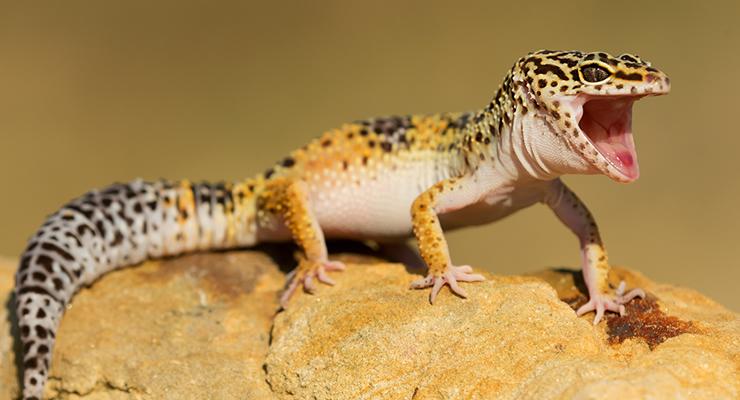Leopard geckos, scientifically known as Eublepharis macularius are a timid and friendly species of geckos. If you want to have a reptile pet then you can start with leopard gecko without any problems. They are native to the arid deserts of South Asia and are one of the common pets for any reptile lover.
Leopard geckos are nocturnal desert reptiles at a slow pace. They are quirky and funny in nature and housing a gecko will award you with multiple memorable incidents. From their loud sound to exhibit their emotions to their rattling tails- leopard geckos will keep you occupied in your free time.
Their name represents their yellow or white skin with black markings- just like a leopard. They have vertical shaped pupils and clean their eyeballs with their tongue. They have prominent outer ears and eyelids- only seen in very few species of geckos.
Their life and size
Baby leopard geckos are three to four inches in length. Adult males can be ten inches long. On the other hand, females are seven to eight inches long- smaller than their male counterparts. The baby hatchlings come with stripes of black or brown which transform into spots as they grow older. Some geckoes can become a foot long if they get the proper living condition.
They are extremely long-living creatures. Usually, the males live longer than female geckoes. While a female may live up to ten years, males can live up to twenty years.
If you have decided to keep a leopard gecko as your pet then you need to have a decent knowledge about leopard gecko care. Read the article till the end to know more.
How to design a house for your gecko
If you are planning on having a single leopard gecko, a simple 10-gallon tank will be sufficient. But, for a pair of geckos, 20 gallons is best. You need to avoid investing in a larger tank because larger tanks will prevent your gecko from spending adequate time for basking and hiding.
The ideal terrarium for a gecko needs to be one foot tall with a screen or lid for fixing some accessories like bulbs.
Your terrarium or pet cage should mimic the arid desert climate of the geckos. Providing them something identical to their natural habitat will help them to grow properly.
As the substrate, you can use reptile carpet, newspapers, paper towels, or flat stones. It is always better to use newspapers or paper towels for the smaller ones. Because, younger leopard geckos tend to ingest sand or smaller stone particles- which are harmful to their health. In case you are using sand or soils, male sure they do not contain any fertilizers. Design the terrarium with stones, logs twigs in such a way that it provides a proper living area for your gecko.
Try to replace the paper towels or newspapers once in a month to maintain hygiene. Interestingly, leopard geckos tend to use the same spot for their waste elimination. You can clean that particular corner once in a week.
As they hail from deserts, they prefer warm temperatures. They are ectotherms and need both hot and cold places to regulate their body temperature. The ideal temperature range for leopard gecko is 88 to 90 degrees F on the hot side and 70 to 80 degrees F on the coder side. In case you want to maintain the temperature precisely, you can use two thermometers on two sides (hot and cold sides) of the terrarium.
It is better to provide them with heat from above. Because leopard geckos tend to bury themselves under the sand(substrate in captivity) and excessive heat in the base can cause them injuries.
Leopard geckos are nocturnal animals. That means you do not need a special UVB lamp in the terrarium. But, try to install a normal lamp to imitate the day and night atmosphere for your geckos.
Additionally, you need to design a humid hiding area for your gecko with a cardboard box filled with moss or vermiculite. Your geckos will use it to rest or to sleep in their day time.
What's to provide them with food?
Another important aspect of leopard gecko care is its food. The leopard geckos eat live insects like Dubia roaches, crickets, and mealworms as their main staple. For occasional treats, you can provide them superworms or wax worms. If you have a juvenile leopard gecko then you need to feed your pet daily. In the case of adult pets, feeding them the alternate day is enough. You need to provide them two insects per inch of their length (i.e. twenty insects for a ten-inch pet). Make sure to dust the insects or gut load these before feeding to your gecko.
You also need to provide enough water for your pet. A water bowl filled with water is a good idea to provide some water to the leopard geckos.
Here is the complete guide about how to take care of a leopard gecko. They are enigmatic pets and will provide you with enough scope to watch them as they hunt or simply roam inside the terrarium.












No Comments